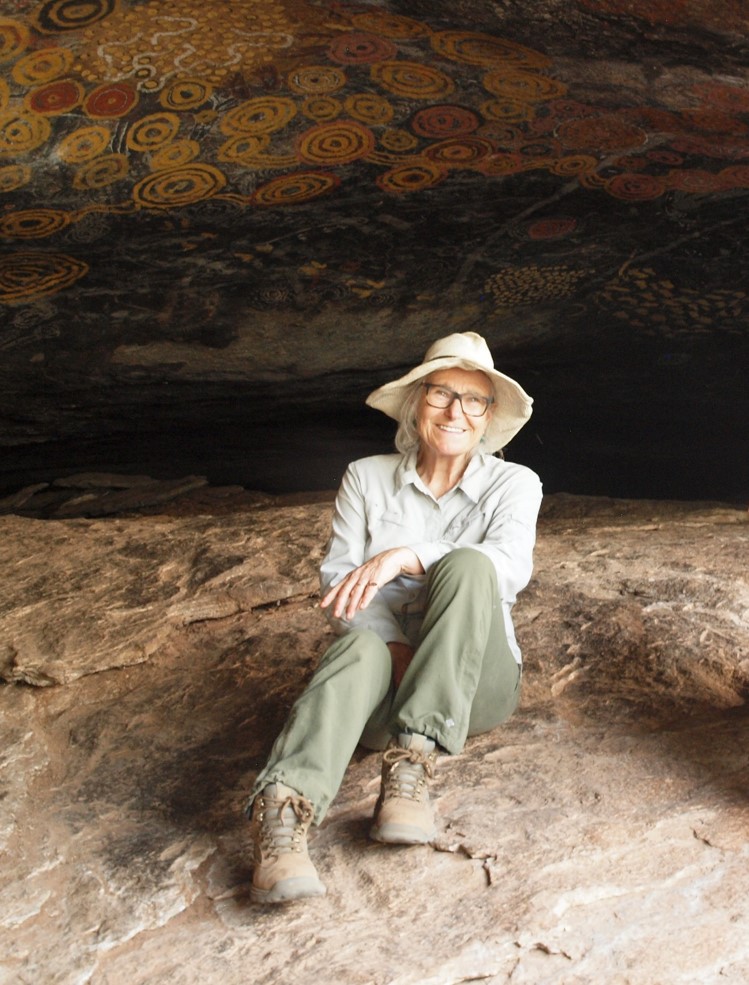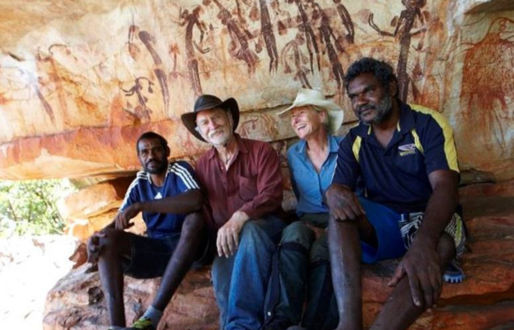A busy year is coming to a close for one of Australia’s most esteemed archaeologists. And where has Adjunct Professor June Ross been? In the continent’s arid heart, advising on the protection of Indigenous rock art.
And lest you think it was a glamourous gig: “I was working in 37-degree heat and sleeping on the ground. Archaeology is incredibly messy; you are dirty all the time, then there’s the flies and getting bitten by things. It’s tough and hot and certainly not for everybody”.
But, says the rock-art specialist, educator and UNE alumna who has spent more than three decades either hiking or being choppered in to remote sites in northern and Central Australia, it is also “incredibly exciting”.
"It’s a cliché, but archaeology is like being a detective,” June says. “You get some clues, consider some theories and then you really have to think and puzzle; it’s an intellectual challenge. Australia is incredibly rich in rock art, and our prehistory – the origins of people on this continent – is significant in terms of understanding how people spread throughout the world. The art is vitally important to that and to us understanding our country and how we have gotten to this point. What’s not to be excited about?
It’s a cliché, but archaeology is like being a detective. You get some clues, consider some theories and then you really have to think and puzzle; it’s an intellectual challenge.
There remains in June something of the enthusiastic nine-year-old who first encountered Aboriginal art not in a sandstone rock shelter but in the Art Gallery of NSW. “My father used to take me deep down into the gallery’s basement, which held the wonderful bark paintings collected from Arnhem Land by [surgeon and art collector] Stuart Scougall,” she said. “We used to end up there and I’ve loved those paintings from the time I first saw them.”

Dr June Ross sitting on a cave hill.
Designer and educator first, archaeologist second
But June didn’t come to study archaeology at UNE until after she had enjoyed a career as a designer, high school teacher and educator at the New England Regional Art Museum (NERAM). “I was writing educational material for Indigenous exhibitions from a very white European museum perspective and thought I should do some Aboriginal Studies to broaden my understanding, so I enrolled in a Bachelor of Arts at UNE,” she recalls. “I was hooked on archaeology from the very first lecture.”
Drawn as she was to remote Australia, June’s postgraduate studies focused on rock art in north-west Queensland and its role in ritual in Central Australia. Since then, she has herself taught rock art at UNE (one of few such courses in Australia) and supervised many postgraduate students. Extensive field work in collaboration with Indigenous communities and colleagues from institutions around the world has significantly advanced her understanding of the art’s significance and informed its conservation.
Research Projects
In recent years, three major ARC collaborative research projects have engaged June. Change and Continuity in the Kimberley has documented hundreds of rock art sites and interrogated their age. Picturing Change has explored rock art since European contact in Central Australia, and the Alive with the Dreaming project provided an archaeological footprint and philosophical explanation for songlines in the Western Desert, culminating in the major Seven Sisters exhibition at the National Museum of Australia and subsequent exhibitions in London, Paris and Frankfurt.
Rock art is regionally distinct and was used to space people in the landscape, bond people, warn people or welcome people. It can tell us about ritual practices, belief systems, food sources or express reverence for ancestors.
“People marked their landscape for all sorts of reasons; it was rarely just functional,” June says. “Rock art is regionally distinct and was used to space people in the landscape, bond people, warn people or welcome people. It can tell us about ritual practices, belief systems, food sources or express reverence for ancestors.”
And Australia’s rich rock art assemblage is world-class, according to June. “There is one site in Central Australia that would challenge the world’s most famous sites and another in the Kimberley that struck me, quite literally, when I first clambered in – and I could say that about quite a few sites I have recorded. The size, the colour, the positioning of the art all add to its drama.”

Dr Ross getting amongst things.
Documenting the Sites
Spanning as it does periods of immense climatic and cultural change, Indigenous rock art speaks volumes about the First Australians and the environment in which they lived. Changes to what and how it was depicted charts the dynamic social and physical conditions.
“The Kimberley is a likely beach-head; the place where the ancestors of today’s Aborigines are likely to have arrived on our continent,” June says. “We want to know how Aboriginal people negotiated their new country and its unpredictable climate, how they spread and adapted, how populations and belief systems changed. One of the mysteries is how they managed to survive at all.”
Tantalisingly, the rugged north-west Kimberley contains some of the oldest in situ motifs in Australia (at least 17,000 years old) and its elegant, adorned human-like figures (known as Gwions) are found nowhere else. Excavations led by Professor Mark Moore (UNE) have shown that people were living here at least 36,000 years ago and, one day, their art may be proven to be older than some of the world’s oldest dated examples.
Sharing such findings with the Indigenous communities in which she has worked is essential to June. As is helping those partners develop archaeological skills of their own, so they can continue to manage their land and culture.
I hope UNE students continue working with Aboriginal people in the years to come to document the sites they are now managing as Traditional Owners.
“You build relationships that you want to maintain,” June says. “We have taken back information in forms that people can enjoy and share, like coloured booklets and videos that have made their way into public libraries and schoolrooms. I hope UNE students continue working with Aboriginal people in the years to come to document the sites they are now managing as Traditional Owners.”
In the meantime, there is “so, so much more to discover”.
“Everyone builds on everyone else’s work and it’s the unexpected things – like suddenly finding a 2,400-year-old pearl at an excavation site – that cheer you along,” June says. “The story will change over and over again as we find out more information – and that’s exciting, too.”


